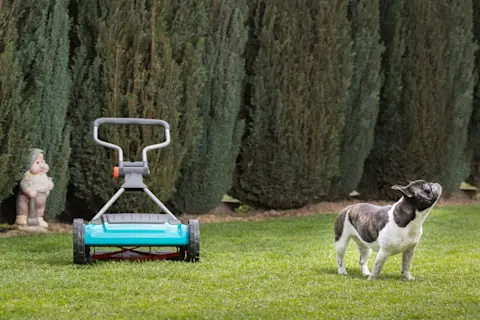Your lawn can do more than just look good—it can help save the planet. Imagine a lawn that stays green and healthy while using less water.
Sounds great, right? Eco-friendly lawn care makes this possible. By changing a few simple habits, you can cut down water waste and protect the environment. Ready to learn how your lawn can become a powerful part of the solution? Keep reading to discover easy tips that save water and make your yard shine.
Benefits Of Eco-friendly Lawn Care
Eco-friendly lawn care offers many benefits for your garden and the environment. It helps save natural resources, supports local wildlife, and keeps your yard healthy. Choosing eco-friendly methods makes your lawn greener and stronger without harming the earth.
Water Conservation
Eco-friendly lawn care reduces water use significantly. Using drought-resistant grass and efficient watering systems cuts water waste. Healthy soil also holds water better, meaning less frequent watering. Saving water helps protect this precious resource for the future.
Reducing Chemical Use
Eco-friendly lawns avoid harmful chemicals like pesticides and synthetic fertilizers. These chemicals can harm pets, wildlife, and soil life. Natural alternatives keep pests under control safely and nourish plants gently. This approach creates a safer and cleaner outdoor space.
Improving Soil Health
Good soil is the foundation of a strong lawn. Eco-friendly practices add organic matter that feeds soil microbes. Healthy soil improves grass growth and reduces erosion. It also helps the lawn resist drought and disease better. Strong soil means a lush and lasting lawn.
Choosing Native And Drought-tolerant Plants
Choosing native and drought-tolerant plants is a smart step in eco-friendly lawn care. These plants thrive with less water and care. They adapt well to local soil and weather. This reduces the need for extra watering and chemicals. Your lawn stays green and healthy, saving water and protecting nature.
Native Grass Varieties
Native grasses grow naturally in your region. They need less water and less fertilizer. These grasses have deep roots that hold soil well. They resist pests and diseases better than non-native types. Native grasses keep lawns looking good all year.
Drought-resistant Shrubs
Drought-resistant shrubs survive with little water. They store water in their leaves or stems. These plants reduce water use in your garden. They offer color and texture without extra care. Shrubs like sage, lavender, and yucca fit well in dry areas.
Benefits For Local Wildlife
Native and drought-tolerant plants provide food and shelter. Birds, bees, and butterflies depend on them. These plants support pollinators and other helpful insects. Your lawn becomes a small habitat for wildlife. It helps keep the local ecosystem balanced and strong.
Smart Watering Techniques
Smart watering techniques help save water and keep your lawn healthy. Using these methods reduces water waste and supports the environment. They are easy to apply and make a big difference.
Optimal Watering Times
Water your lawn early in the morning or late in the evening. These times reduce water loss from evaporation. Your lawn will absorb water better and stay green longer.
Avoid watering during midday when the sun is strong. Watering at the right time also helps prevent plant diseases. A simple change in timing saves a lot of water.
Drip Irrigation Systems
Drip irrigation delivers water directly to the roots of plants. This system uses less water than traditional sprinklers. It reduces runoff and keeps the soil moist where plants need it most.
Drip systems are easy to install and adjust. They work well for flower beds, shrubs, and vegetable gardens. Using drip irrigation supports healthy plant growth while saving water.
Rainwater Harvesting
Collect rainwater to water your lawn and garden. Use barrels or tanks to store rain from your roof. This water is free and helps reduce your water bill.
Rainwater is better for plants because it does not contain chemicals found in tap water. Using rainwater also lowers the demand on city water systems. It is a smart and natural way to care for your lawn.
Organic Lawn Fertilizers And Pest Control
Organic lawn fertilizers and pest control offer a natural way to keep your lawn healthy. These methods protect the soil and water from harmful chemicals. They help your lawn grow strong and green without damage to the environment. Using organic options supports local wildlife and reduces pollution.
Natural Fertilizer Options
Natural fertilizers come from plants, animals, or minerals. Compost, bone meal, and seaweed extract are popular choices. These fertilizers release nutrients slowly, feeding grass over time. They improve soil structure and water retention. Natural fertilizers avoid harsh chemicals that can harm the earth and water supply.
Eco-friendly Pest Management
Eco-friendly pest control uses natural predators and organic sprays. Ladybugs and nematodes help control harmful insects. Neem oil and insecticidal soap work without toxic chemicals. These methods protect beneficial bugs and keep your lawn safe. Avoid synthetic pesticides that can poison pets and pollute water.
Composting Benefits
Composting turns kitchen scraps and yard waste into rich soil. It reduces landfill waste and lowers greenhouse gases. Compost adds vital nutrients and microbes to your lawn. It improves soil health and helps retain moisture. Composting is a simple way to recycle and boost lawn growth naturally.
Mowing Practices For A Healthy Lawn
Mowing is an essential part of lawn care. It keeps your grass healthy and green. Proper mowing also helps save water and protect the environment. Using the right mowing techniques supports strong roots and reduces lawn stress. These simple steps make your lawn eco-friendly and beautiful.
Correct Mowing Height
Set your mower to the right height for your grass type. Cutting grass too short weakens it. Taller grass shades the soil and holds moisture better. This reduces water use and stops weeds from growing. Aim to cut only one-third of the grass blade at a time.
Using Electric Or Manual Mowers
Choose electric or manual mowers to reduce pollution. Gas mowers release harmful fumes and waste fuel. Electric mowers run quietly and use less energy. Manual reel mowers are silent and need no fuel. These options help keep the air clean and save energy.
Leaving Grass Clippings
Leave grass clippings on the lawn after mowing. They return nutrients to the soil naturally. This lowers the need for chemical fertilizers. Clippings also help keep the soil moist. Mulching your lawn saves water and supports healthy growth.

Credit: www.discovermagazine.com
Soil Care And Aeration
Healthy soil forms the base of a vibrant, eco-friendly lawn. Caring for your soil helps grass grow strong and uses water more efficiently. Proper soil care and aeration improve air, water, and nutrient flow to roots. This creates a lawn that needs less water and fewer chemicals. Understanding how to aerate and nourish soil keeps your lawn green and saves the planet.
Aeration Methods
Aeration means making small holes in the soil. These holes let air and water reach grass roots better. Core aeration removes small plugs of soil from the lawn. Spike aeration pokes holes without removing soil. Core aeration works best for thick, compacted lawns. Aerate your lawn once or twice a year for best results.
Adding Organic Matter
Organic matter like compost or mulch helps soil hold water. It also feeds helpful microbes in the soil. Spread a thin layer of compost over the lawn in spring or fall. Organic matter improves soil texture and supports healthy grass growth. Avoid using chemical fertilizers that can harm soil life.
Preventing Soil Compaction
Soil compaction stops roots from growing deep. It also reduces water absorption and air flow. Avoid walking or driving heavy equipment on your lawn. Use stepping stones or paths in high-traffic areas. Regular aeration helps break up compacted soil naturally. Keep soil loose to create a strong, water-wise lawn.
Creating A Sustainable Lawn Care Schedule
Creating a sustainable lawn care schedule helps save water and protect the environment. It organizes tasks to keep your lawn healthy through every season. Planning ahead reduces waste and promotes green practices. A well-planned schedule supports strong grass and fewer chemicals. Follow simple steps to care for your lawn efficiently.
Seasonal Tasks
Spring calls for cleaning up debris and aerating soil. Summer needs regular mowing and checking for pests. Fall is perfect for overseeding and adding mulch. Winter requires minimal care but protects grass from damage. Adjust tasks based on weather and grass type. This keeps your lawn thriving year-round.
Watering Frequency
Water early in the morning to reduce evaporation. Most lawns need about one inch of water weekly. Avoid daily watering to encourage deep roots. Use rain sensors or soil moisture meters to guide watering. Reduce water use during rainy periods. Proper watering saves water and strengthens grass.
Maintenance Tips
Cut grass to about three inches tall. Longer grass shades soil and holds moisture. Leave grass clippings on the lawn to add nutrients. Test soil pH and add natural fertilizers if needed. Remove weeds by hand to avoid chemicals. Regular maintenance keeps your lawn green and eco-friendly.

Credit: www.youtube.com

Credit: www.extraspace.com
Frequently Asked Questions
What Are The Benefits Of Eco-friendly Lawn Care?
Eco-friendly lawn care conserves water, reduces chemical use, and supports local wildlife. It saves money and promotes a healthier environment. Sustainable practices improve soil health and reduce pollution, helping protect the planet for future generations.
How Can I Save Water When Watering My Lawn?
Water your lawn early morning or late evening to minimize evaporation. Use drip irrigation or soaker hoses for efficient watering. Adjust sprinklers to avoid watering sidewalks or driveways, and water deeply but less frequently to encourage strong root growth.
Which Grass Types Need Less Water For Lawns?
Drought-tolerant grasses like Bermuda, Buffalo, and Zoysia require less water. Native grasses adapt well to local climates and reduce irrigation needs. Choosing the right grass type saves water and keeps your lawn healthy in dry conditions.
How Does Mulching Help Eco-friendly Lawn Care?
Mulching retains soil moisture and reduces the need for frequent watering. It suppresses weeds, minimizing chemical herbicide use. Mulch also adds nutrients to the soil as it decomposes, improving lawn health naturally.
Conclusion
Caring for your lawn in an eco-friendly way helps save water every day. It protects the planet and keeps your yard healthy. Small steps like watering less and using natural products make a big difference. Your lawn can look good without wasting resources.
Choose smart methods that support nature and reduce harm. Start today for a greener, cleaner future. Every effort counts toward a better world.
